

Paasmaker — Paasmaker 0.9 documentation. Introduction to-paa s. What Exactly is Cloud Foundry? We Recommend These Resources The PaaS on PaaS marketure has me confused.

The ecosystem surrounding Cloud Foundry demonstrates how PaaS, the middle level between SaaS and IaaS is actually a multi-layered market space. A way to unwind the recursive relationship between Cloud Foundry and ecosystem partners is to first start calling the technology a ‘cloud-enabled platform’, and limit PaaS as an instantiation of the cloud-enabled platform delivered as a service.
The CloudFoundry ecosystem partners (e.g. AppFog, Stackato, Uhuru, Tier3) seem to be competing on ease of use enhancements, bundled technology (e.g. language support, cache support, database support), or managed hosting. Using Federated Authentication via OpenID in Google App Engine - Google App Engine. Everything Is PaaSible.
PaaS will allow application developers to always use the right tool for the job; including tools that aren’t even conceived as potential application tools.
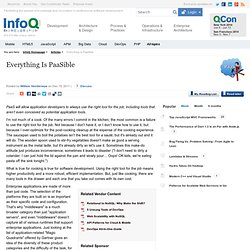
I'm not much of a cook. Of the many errors I commit in the kitchen, the most common is a failure to use the right tool for the job. What is Platform as a Service (PaaS)? PaaS – Platform as a Service what is platform as a serviceAs per NIST’s definition of Cloud Computing, Cloud has 5 essential Characteristics, 4 deployment models and service models.
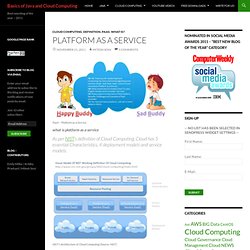
NIST’s Architecture of Cloud Computing (Source: NIST) What exactly Service models mean? As PaaS funding winds down, Standing Cloud raises $3M — Cloud Computing News. Threading the Needle with PaaS-based Policy. After my previous posts on PaaS, JP Morgenthal (Twitter: @jpmorgenthal) and I have had some offline conversations.
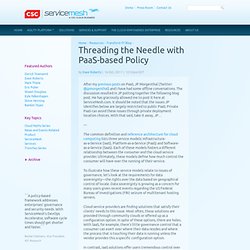
The discussion resulted in JP putting together the following blog post. OpenShift: Is it really PaaS? Redhat recently announced an upgraded version of OpenShift with exciting new features including support for Java EE6, Membase, MongoDB and more.
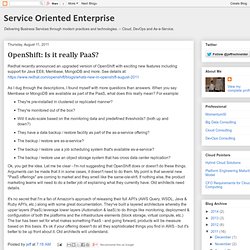
CumuLogic. PaaS Is The Future Of Cloud Services: Cumulogic Goes Public Beta. Cumulogic, the first company to offer private PaaS solution, today announced that they are making their platform open to public in beta form.

You can download Cumulogic platform from their website and run on public and private clouds. They offer a powerful Java PaaS supporting all the Java Frameworks including Spring. I have been talking to Cumulogic from their early days and I am pretty impressed with their platform. Once the IT department deploys their platform on a public or private cloud platform, the developers can just upload their war files and, boom, they have a easily scalable application running on the cloud. What’s in Store for 2011: A Few Predictions.
It is true that predictions for the new year are best made before it begins.
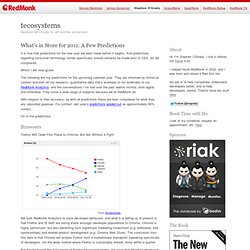
And predictions regarding consumer technology trends specifically should certainly be made prior to CES. Coté's People Over Process » Despite much hope, PaaS momentum hasn’t blown the doors off yet. Touted at the next thing in cloud, Platform as a Service is receiving much attention now. While PaaS has been far from a failure, it hasn’t been a mega success…yet. I’ve been talking with several people about Platform as a Service use recently: with all the vendors (and us analysts as well!) Going on about how great it is, I’ve been trying to assertion both current momentum and ongoing developer desire. The point of PaaS is to make a developer’s life even easier: you don’t need to manage your cloud deployments at the the lower level of IaaS, or even wire together your Puppet/Chef scripts. The promise of PaaS is similar to that of Java application servers: just write your applications (your business logic) and do magic deployment into the platform, where everything else is taken care of.
Taking Stock Coming across PaaS usage numbers can be difficult. Anant Jhingran's Musings: Pain vs. Gain for Different Cloud Layers. I have talked about in the past that cloud decisions are not made in vacuum, there is a definite tradeoff of pain vs gain.

On the gain side are obvious reductions in capex, opex and even increased business flexibility (by making IT available very easily so that more things get done). On the pain side are increased requirements for standardization, increased application model change, and risks (perceived or real) that come with increased sharing. Enterprises want app stores too. (Page 1 of 2)Apple's iPhone didn't just revolutionize smartphones; it also introduced the first concrete and successful app store in the world.
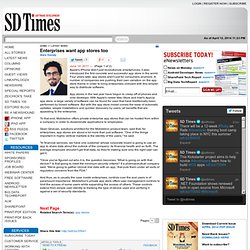
Four years later, app stores aren't just for consumers anymore. A number of companies are pushing their own variation on the app store theme in order to bring enterprises onboard with this simpler way to distribute software. App stores in the last year have begun to creep off of phones and onto desktops. With Apple's newer Mac Store and Intel's AppUp app store, a large variety of software can be found for uses that have traditionally been performed by boxed software. But with the app store model comes the ease of automatic updates, simple installations and quicker discovery by users, all benefits that are appealing to the enterprise. To that end, MobileIron offers private enterprise app stores that can be hosted from within a company in order to disseminate applications to employees.
The platform-as-a-service cloud: Developers are in charge. Platform-as-a-service (PaaS) cloud computing, in which full-fledged application development and deployment capabilities are provided rather than just raw iron and compute cycles such as in Amazon Web Services, is set to gather steam as a deployment option for programmers.

But the market is still in start mode, and developers are calling the shots. Currently, PaaS is a $2.8 billion market, but "it will become over the next 10 years a $10 billion market," says Forrester Research analyst Stefan Ried, who recently published a report on PaaS. Microsoft's Windows Azure and Salesforce.com's Force.com are currently the leading platforms for coders in the fledgling PaaS marketplace, according to Forrester. On the Battle Lines of PaaS–The Future is Bifurcated. Friend and one-time colleague Krishnan Subramanian posted recently his view of the different ways PaaS products can be differentiated. Very briefly, Krish classed products in three distinct categories; Traditional PaaS models (push your app to the PaaS and all the underlying stuff is taken care of).
Examples – Heroku, Google App Engine, PHPfogThe Amazon model (package the PaaS but allow devs to get their hands on the underlying infrastructure). Node.js PaaS Nodejitsu Open-Sources Several Tools. Advanced Computer Science Courses : Paper Trail. Below I’ve collected some links to advanced computer science courses on-line. Why a JavaScript hater thinks everyone needs to learn JavaScript in the next year. I’ve long looked at JavaScript as a second-class citizen in the programming world. Early on, it was the source of numerous security problems; it was a nice bit of glue to patch together HTML applications with a bit of styling, but nobody would use it for serious code; and so forth. Java, Ruby, Python, they were the languages for doing real work. But my attitude toward JavaScript has changed completely in the past few years. JavaScript has “grown up.”
I’m sure there are many JavaScript developers who would take issue with that judgement, and argue that JavaScript has been a capable, mature, and under-appreciated language all along. The potential of Node.js Node.js has the potential to revolutionize web development. App Engine: Google's deepest secrets as a service [printer-friendly] The software scales. But will the Google rulebook? Google will never open source its back end. You'll never run the Google File System or Google MapReduce or Google BigTable on your own servers. Except on the rarest of occasions, the company won't even discuss the famously distributed software that underpins its sweeping collection of web services.